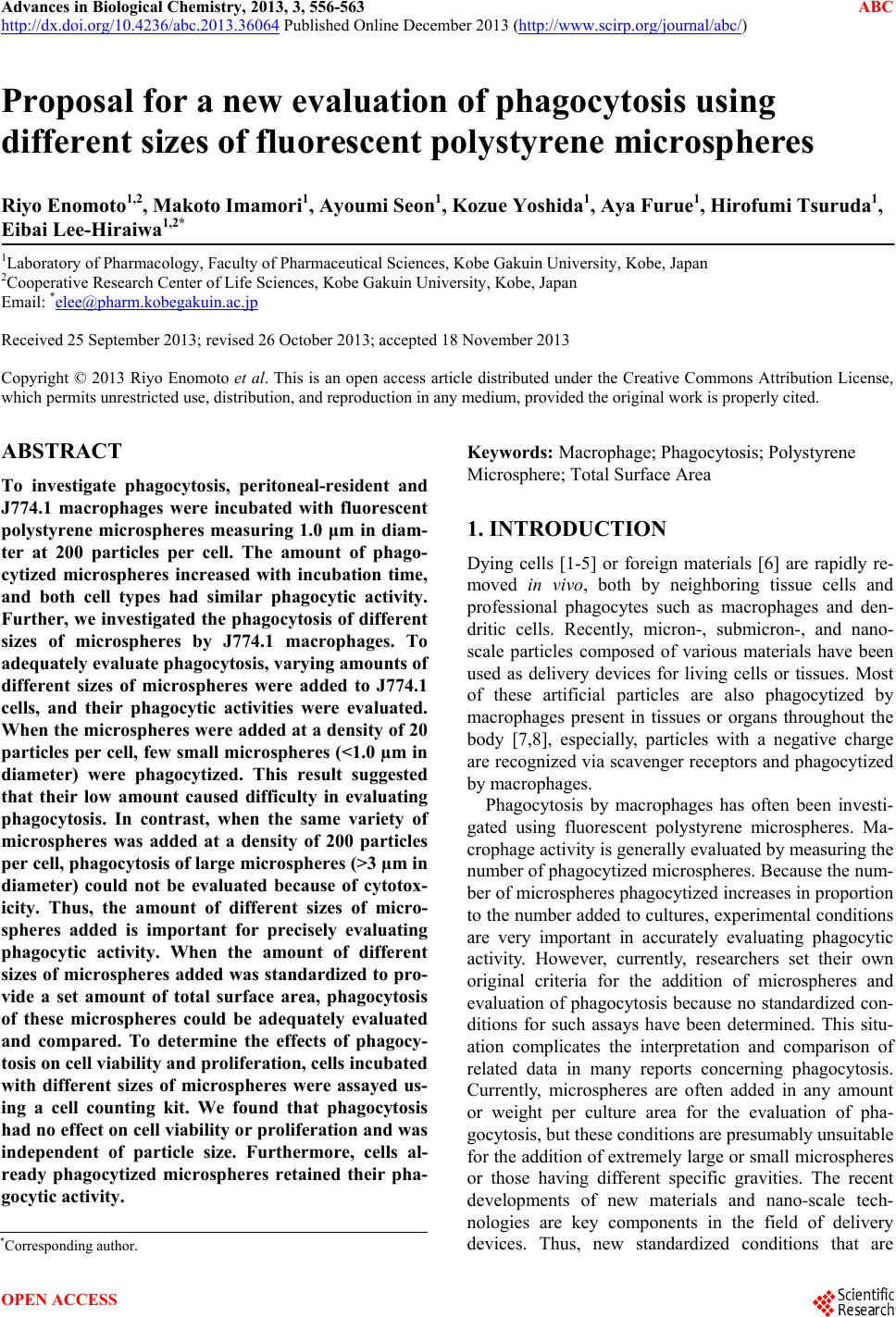
Advances in Biological Chemistry, 2013, 3, 556-563 ABC
http://dx.doi.org/10.4236/abc.2013.36064 Published Online December 2013 (http://www.scirp.org/journal/abc/)
Proposal for a new evaluation of phagocytosis using
different sizes of fluorescent polystyrene microspheres
Riyo Enomoto1,2, Makoto Imamori1, Ayoumi Seon1, Kozue Yoshida1, Aya Furue1, Hirofumi Tsuruda1,
Eibai Lee-Hiraiwa1,2*
1Laboratory of Pharmacology, Faculty of Pharmaceutical Sciences, Kobe Gakuin University, Kobe, Japan
2Cooperative Research Center of Life Sciences, Kobe Gakuin University, Kobe, Japan
Email: *elee@pharm.kobegakuin.ac.jp
Received 25 September 2013; revised 26 October 2013; accepted 18 November 2013
Copyright © 2013 Riyo Enomoto et al. This is an open access article distributed under the Creative Commons Attribution License,
which permits unrestricted use, distribution, and reproduction in any medium, provided the original work is properly cited.
ABSTRACT
To investigate phagocytosis, peritoneal-resident and
J774.1 macrophages were incubated with fluorescent
polystyrene microspheres measuring 1.0 μm in diam-
ter at 200 particles per cell. The amount of phago-
cytized microspheres increased with incubation time,
and both cell types had similar phagocytic activity.
Further, we investigated the phagocytosis of different
sizes of microspheres by J774.1 macrophages. To
adequately evaluate phagocytosis, varying amounts of
different sizes of microspheres were added to J774.1
cells, and their phagocytic activities were evaluated.
When the microspheres were added at a density of 20
particles per cell, few small microspheres (<1.0 µm in
diameter) were phagocytized. This result suggested
that their low amount caused difficulty in evaluating
phagocytosis. In contrast, when the same variety of
microspheres was added at a density of 200 particles
per cell, phagocytosis of large microspheres (>3 µm in
diameter) could not be evaluated because of cytotox-
icity. Thus, the amount of different sizes of micro-
spheres added is important for precisely evaluating
phagocytic activity. When the amount of different
sizes of microspheres added was standardized to pro-
vide a set amount of total surface area, phagocytosis
of these microspheres could be adequately evaluated
and compared. To determine the effects of phagocy-
tosis on cell viability and proliferation, cells incubated
with different sizes of microspheres were assayed us-
ing a cell counting kit. We found that phagocytosis
had no effect on cell viability or proliferation and was
independent of particle size. Furthermore, cells al-
ready phagocytized microspheres retained their pha-
gocytic activity.
Keywords: Macrophage; Phagocytosis; Polystyrene
Microsphere; Total Surface Area
1. INTRODUCTION
Dying cells [1-5] or foreign materials [6] are rapidly re-
moved in vivo, both by neighboring tissue cells and
professional phagocytes such as macrophages and den-
dritic cells. Recently, micron-, submicron-, and nano-
scale particles composed of various materials have been
used as delivery devices for living cells or tissues. Most
of these artificial particles are also phagocytized by
macrophages present in tissues or organs throughout the
body [7,8], especially, particles with a negative charge
are recognized via scavenger receptors and phagocytized
by macrophages.
Phagocytosis by macrophages has often been investi-
gated using fluorescent polystyrene microspheres. Ma-
crophage activity is generally evaluated by measuring the
number of phagocytized microspheres. Because the num-
ber of microspheres phagocytized increases in proportion
to the number added to cultures, experimental conditions
are very important in accurately evaluating phagocytic
activity. However, currently, researchers set their own
original criteria for the addition of microspheres and
evaluation of phagocytosis because no standardized con-
ditions for such assays have been determined. This situ-
ation complicates the interpretation and comparison of
related data in many reports concerning phagocytosis.
Currently, microspheres are often added in any amount
or weight per culture area for the evaluation of pha-
gocytosis, but these conditions are presumably unsuitable
for the addition of extremely large or small microspheres
or those having different specific gravities. The recent
developments of new materials and nano-scale tech-
nologies are key components in the field of delivery
devices. Thus, new standardized conditions that are
*Corresponding author.
OPEN ACCESS